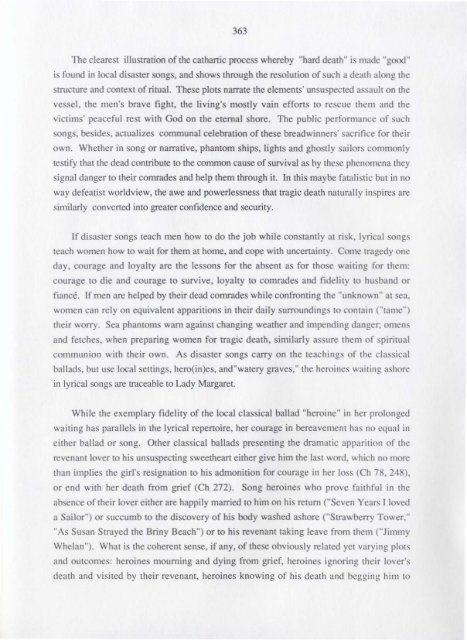Untitled - Memorial University's Digital Archives - Memorial ...
Untitled - Memorial University's Digital Archives - Memorial ...
Untitled - Memorial University's Digital Archives - Memorial ...
You also want an ePaper? Increase the reach of your titles
YUMPU automatically turns print PDFs into web optimized ePapers that Google loves.
363<br />
The clearest illustration of the cathartic process whereby "hard death" is made "goOO"<br />
is found in local disaster songs, and shows through the resolution of such a death along the<br />
structure and context of ritual. These plots narrate the elements' unsuspected assault on the<br />
vessel, the men's brave fight, the living's mostly vain efforts to rescue them and the<br />
victims' peaceful rest with God on the eternal shore. The public perfonmmce of such<br />
songs, besides, actualizes communal celebration oflhese breadwinners' sacrifice for their<br />
own. Whether in song or narrative, phantom ships. lights and ghostly sailors commonly<br />
testify that the dead contribute to the common cause of survival as by these phenomena they<br />
signal danger to their comrades and help them through it. In this maybe fatalistic bllt in no<br />
way defeatist worldview, the awe and powerlessness that tragic death naturally inspires are<br />
similarly converted into greater confidence and security.<br />
If disaster songs teach men how 10 do the job while conslantly at risk, lyrical songs<br />
teach women how to wait for them at home, and cope with uncertainty. Come tragedy one<br />
day, courage and loyalty are the lessons for the absent as for those waiting for them:<br />
courage to die and courage to survive. loyalty to comrades and fidelity to husband or<br />
fiance. If men are helped by their dead comrades while confronting the "unknown" at sea,<br />
women can rely on equivalent apparitions in their daily surroundings to contain ("tame")<br />
their worry. Sea phantoms warn against changing weather and impending danger, omens<br />
and fetches, when preparing women for tragic death, similarly assure them of spirilUal<br />
communion with their own. As disaster songs carryon the teachings of the classical<br />
ballnds, but use local settings, hero(in)es, and"watery graves," the heroines w'liting ashore<br />
in lyrical songs are traceable to Lady Margaret.<br />
While the exemplary fidelity of the local classical ballad "heroine" in her prolonged<br />
waiting has parallels in the lyrical repertoire, her courage in bereavement has no equal in<br />
either ballad or song. Other classical ballads presenting the dramatic apparition of the<br />
revenant lover to his unsuspecting sweetheart either give him the last word, which no more<br />
than implies the girl's resignation to his admonition for courage in her loss (Ch 78, 248),<br />
or end with her death from grief (Ch 272). Song heroines who prove faithful in the<br />
absence of their lover either are happily married to him on his return ("Seven Years I loved<br />
a Sailor") or succumb to the discovery of his body washed ashore ("Strawberry Tower,"<br />
"As Susan Strayed the Briny Beach") or to his revenant taking leave from them ("Jimmy<br />
Whelan"). What is the coherent sense, if any, of these obviously related yet varying plots<br />
and outcomes: heroines mourning and dying from grief, heroines ignoring their lover's<br />
death and visited by their revenant, heroines knowing of his death and begging him to

















